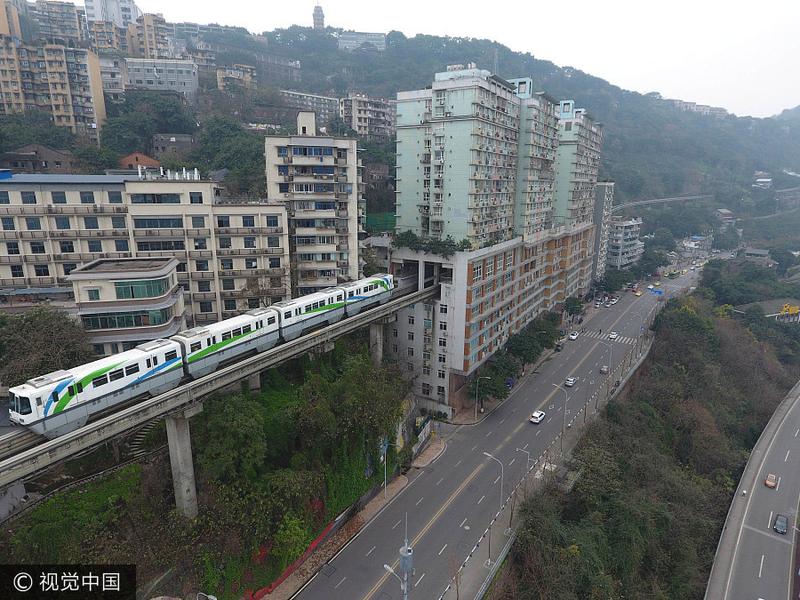



On an overpass more than a dozen meters tall, a train runs through a 19-story residential building, and then reemerges on the other side.

A train runs along the tracks of light rail Line 2 that penetrates residential buildings at Liziba Station in Chongqing, March 18, 2017. [Photo/VCG]
For residents in southwest China's Chongqing Municipality, the train trip has been a daily commute since 2004, when the local government built Liziba station between the sixth and eighth floors of the building on an essential train route.
But in recent years, tourists' videos and photos of the sky train went viral on Chinese social media.
"Sky corridors" linking closely built high-rises and hot pot parties under large neon-lit billboards are just some of the things in Chongqing that have captivated internet users across the country.
During this year's Spring Festival Holiday, from Feb. 4 to Feb. 10, the mountain city with 30 million permanent residents saw 47 million visitors, ranking first among Chinese cities.
During a campaign on China's popular short-video sharing platform Douyin, which lets users log places they visited during the Spring Festival, the city also became the top destination.
Chongqing sits at the confluence of the Yangtze River and the Jialing River. In the middle is the Yuzhong peninsula, home to the heart of the city.
Unlike China's sprawling, flat cities like Beijing and Shenzhen, Chongqing is a high-density city. Its mountains and rivers mean it is harder to build on, so there is a greater need to build up and pack high rises in every available space.
As such, Chongqing's infrastructure and public transportation are very different from other Chinese cities.
Streets run through both the first and the eighth floor of a building, buses park inside high-rises, and basketball courts are built on roofs.
"It's a fresh, new experience for me compared to living in a flat city, especially in terms of transport," said Yang Hua, a young tourist from the southern Chinese city of Guangzhou.
Apart from the train that runs through the building, Yang also experienced a cross-river cableway which offers an overview of the Yangtze River as well as a ferry ride.
"Chongqing's online fame is indispensable with the extraordinary urban designs tailored to the rivers and its mountainous landscape," said Zhang Haipeng, a senior engineer with the municipal geographic information center.
Thanks to the internet, young people like Yang make up a large part of the tourists. People born after 1980 account for over 40 percent of the visitors in Chongqing, according to China online travel service provider Ctrip.
To attract more young people, the city has been working to create more nightlife attractions. One of the initiatives is to recruit street artists from around the world to the Jiujie block in the north of the city.
The block is now a major nightlife center in Chongqing, bustling with food stalls, pubs and boutique shops. An average daily flow of 130,000 people visited the block during holidays in 2018.
The explosive growth of visitors following Chongqing's online publicity has also posed new challenges, as many of the hot sites are part of the public transportation or residential buildings which are not designed for tourists.
At the Liziba train station, the local government set up a new viewing platform and increased the number of toilets. At the Yangtze cableway, an online reservation and queuing system were put in place.
The city has also set up new sightseeing bus routes and increased ferry rides on the river.
"High-quality and effective tourism products and services are what make instant fame long-lasting," said Liu Qi, head of the municipal culture and tourism development commission.
